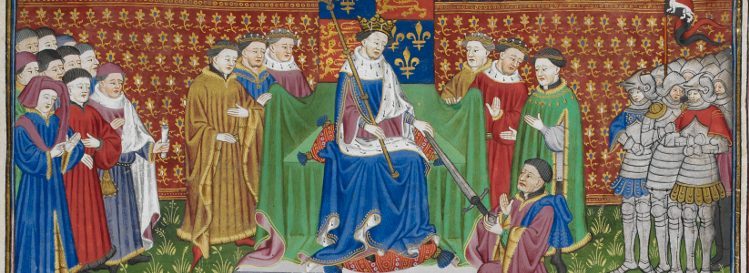Great households in the Middle Ages were of necessity peripatetic.This applied above all to the king and his court. Residences had to be cleaned and aired. They had to be revictualed for the next stay. Thus the royal household would often move on to a new house or castle. These were often royal residences, but often too they were the great houses of the nobility or great monastic establishments.
This does not pretend to list all the houses and castles that played host to the King during over forty years of rule, but it lists some of the residences that served Henry and his household and court on a fairly regular basis. Great abbeys like St. Albans, Bury St. Edmunds and Leicester Abbey, as others that housed the King as a guest and often parliament gatherings as well, are not included. The castles of the North like Bamburgh and Dunstanburgh, his sojourn in France and his later exile in Scotland, or his wanderings through Lancashire as a fugitive, have similarly been omitted. Interestingly, in the 1450s King Henry stayed several times as a guest in Chertsey Abbey, where he would later be buried after his murder in the Tower.
Windsor Castle:
Windsor was the place of Henry's birth and his residence while in the care of his mother, Catherine of Valois, during the first years of his life, although he was occasionally brought to London, to Westminster for the opening of his parliaments. At Easter 1428 Queen Catheine took him to Hertford castle and to the abbey of St. Albans. Windsor castle, however, remained a favoured residence, in sight of which he established and oversaw his foundation of Eton college.
Eltham:
As a boy King Henry was often in residence at the royal palace of Eltham, some 14 km south-east of central London. He was certainly staying there in 1425 during the armed fracas between his uncle Duke Humphrey of Gloucester and his great-uncle Bishop Henry Beaufort of Winchester. He continued to be a frequent visitor throughout his reign.
Palace of Westminster:
The royal palace adjoining the abbey of Westminster was Henry's usual residence in London itself. He does not seem to have used the Tower, which was renowned as a stronghold and less as a residence of comfort and space. His connection with the Tower of London belongs to the last years of his life, to his years of imprisonment under the Yorkist usurper.
The Royal Household:
In 1428 Henry was established with his own household separate from that of his mother, the Queen-Dowager. He was allotted the castles of Wallingford and Hertford for use in Summer, and Windsor and Berkhamstead for the Winter.
Kennington Palace:
Built by the Black Prince and later demolished by Henry VIII, Kennington was a royal residence at that time outside the city of London, to which Henry frequently repaired, as had his father and his grandfather before him. Like Eltham, Kennington served as a regular residence to the King and his household.
Sheen Palace:
Sheen Manor/Palace was rebuilt by the King's father. His death in 1422 interrupted the construction, which was resumed by the Council when King Henry was 8 years old. It was continued by King Henry himself throughout the 1440s. It was one of the residences near London that was regularly used by the King. After a fire in 1497, Henry VII Tudor built Richmond Palace in its place.
Kenilworth Castle:
Kenilworth in Warwickshire had been largely reconstructed and 'modernised' by King Henry's great-grandfather, John of Gaunt. It was regarded as a comfortable and safe castle, to which the King could retire in times of danger and unrest. Queen Margaret brought the King and the court here for safety after Henry's great illness and during the unrest caused by York and the Nevilles.
Leicester and Tutbury Castle in Staffordshire were similarly centres of Lancastrian support and served as places of safe refuge when needed.
Greenwich Palace:
Built by Duke Humphrey of Gloucester in 1433, Greenwich Palace came into the King's hands after his uncle's death in 1447. It was given to Queen Margaret, who renamed it the Palace of Placentia, carrying out several alterations and beautified it. The King took up residence here occasionally, although for him it ranked second to the near-by and more popular manor of Eltham.
Clarendon Palace:
Clarendon east of Salisbury in Wiltshire had been a royal hunting lodge from probably late Saxon times. Although Henry had enjoyed hunting as a boy, he did not visit Clarendon Palace at all frequently, perhaps because of its distance from London. However, it was at Clarendon in August 1453 that the King was struck by the first signs of that great (and mysterious) disorder or illness that was to lay him low for over a year and whose after-effects probably plagued him in some form for the remainder of his life. He left Clarendon on 3rd October 1453 and was brought back slowly to Windsor.
Cheylesmore Manor:
Cheylesmore Manor and its hunting park served as residence to King Henry during his stays in Coventry. The manor dated back into the 13th century and served most famously as a hunting lodge to the Black Prince (father of Richard II). The castle at Coventry had been destroyed long before by King Stephen and its ruinous state certainly offered no comfort to a king in 15th century.
